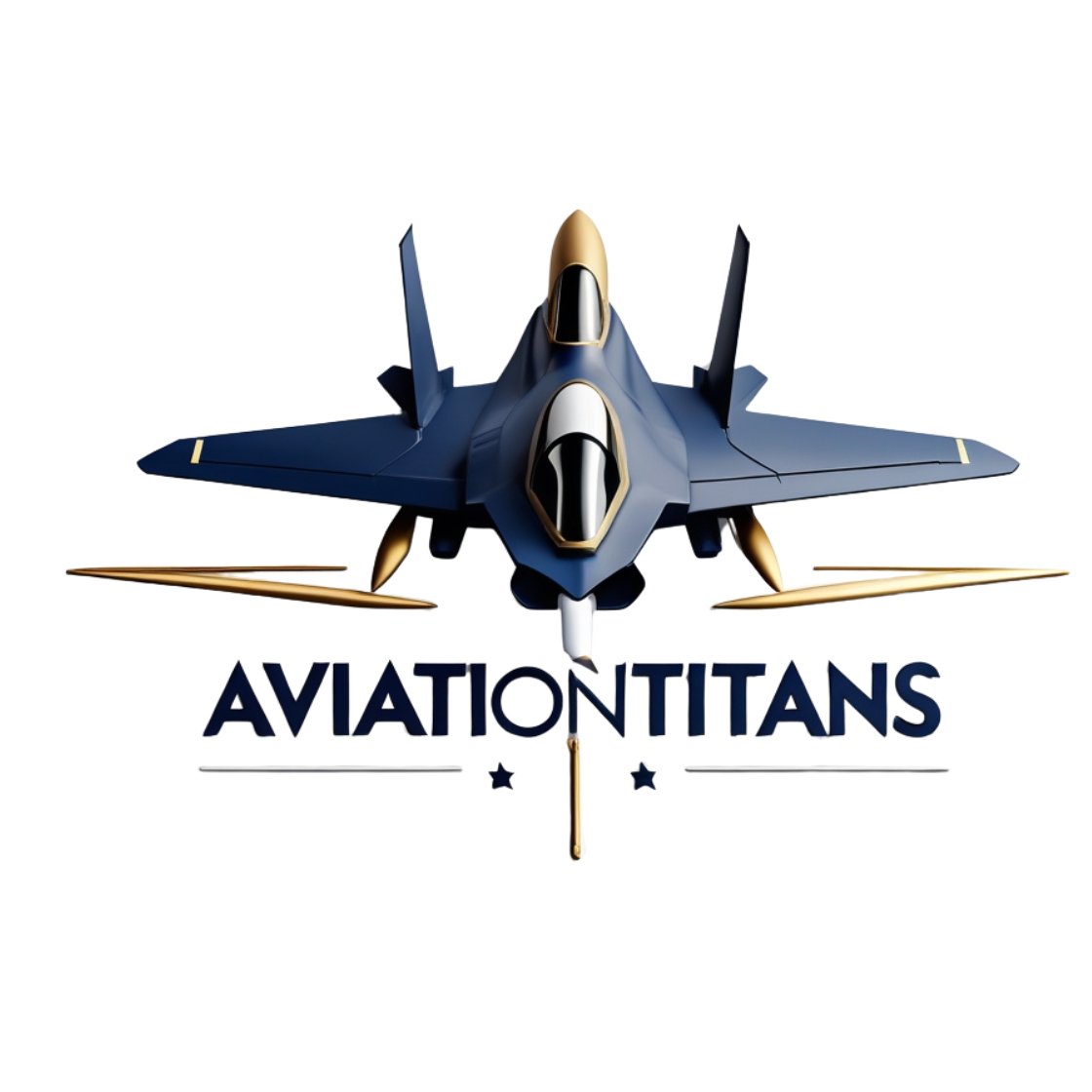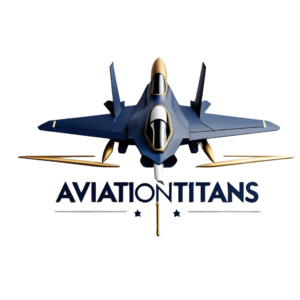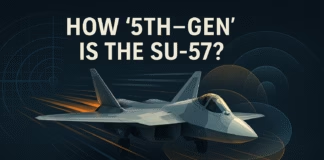Why this topic matters now
The F-35’s Tech Refresh 3 (TR-3) hardware is finally flowing and sets the foundation for Block 4—a multi-year package of 70+ upgrades spanning sensors, weapons, EW, and computing. In practical terms, TR-3 gives the jet far more processing headroom so future software drops can unlock new weapons, AI-assisted cues, and advanced teaming with uncrewed aircraft. For operators, the next five years aren’t just incremental; they reshape how the Lightning II senses, decides, and shoots. The StrategistDefense News
What counts as “future tech” for the F-35 in 2025–2030?
Three lanes dominate near-term capability growth:
- Directed energy (DE): maturing fighter-class laser and high-power microwave (HPM) concepts for self-defense and precision effects.
- New missiles: integrating longer-reach air-to-air and standoff air-to-surface weapons (AIM-260, LRASM/JASSM, JSM, StormBreaker, AARGM-ER).
- AI cues: using TR-3/Block 4 compute to fuse sensors faster, prioritize targets, and coordinate with drones (CCA-style wingmen). Congress.govF-35 Lightning II
Directed energy on a stealth fighter: what’s real vs hype?
U.S. DoD has multiple high-energy laser (HEL) and HPM lines, but power, thermal, and aperture limits make fighter integration hard. The most credible 2025–2030 path is podded systems that draw power from the aircraft and vent heat through advanced cooling—promising for blinding or burning small seekers, frying inbound drones, and providing ultra-fast “magazine depth” at short range. A 2024 Congressional Research Service survey outlines the state of HEL/HPM tech, timelines, and integration issues; it’s realistic about the leap from lab to fighters. Lockheed also details modular DE systems scaling from tens to 100+ kW, with prior public goals to test 50–150 kW class lasers relevant to tactical aircraft. Bottom line: no official fielded laser on the F-35 yet, but the building blocks (pods, power management, beam control, cooling) are advancing—and TR-3’s compute helps with beam quality control and cueing. Expect experiments and risk-reduction this decade, with operational decisions hinging on power/thermal margins and cost-per-shot advantages. Congress.govLockheed MartinBreaking Defense
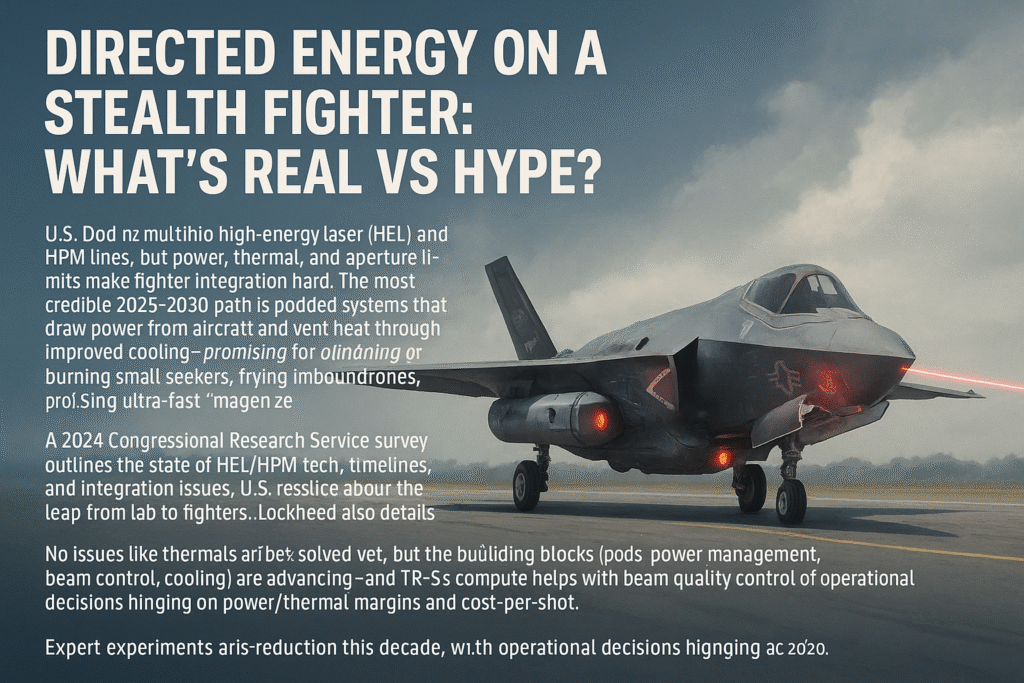
New missiles: longer reach, smarter effects
Air-to-air (A2A): The AIM-260 Joint Advanced Tactical Missile (JATM) is designed to overmatch modern long-range threats and eventually backfill AIM-120 buys. FY-2026 budget documents show initial procurement lines for AIM-260 across the Navy and Air Force, signaling transition from pure development to early fielding. Integration details are closely held, but the F-35 is a prime beneficiary as Block 4 matures. Naval NewsThe National Interest
Anti-ship and standoff strike: The AGM-158C LRASM is moving through F-35 integration tests (F-35C first, then F-35B), pairing the Lightning II’s survivability with long-range maritime strike. JASSM family integration continues in parallel. For Europe and the Pacific, the Joint Strike Missile (JSM)—internal-bay compatible for some configurations—has begun deliveries to Norway and is being adopted by additional F-35 customers, expanding stealthy, terrain-following strike reach. ReutersThe AviationistMedia – Lockheed Martinkongsberg.comThe War Zone
Networked smart weapons and SEAD/DEAD: StormBreaker (GBU-53/B) testing on carrier variants points to all-weather moving-target attack with data-linked retargeting, while AARGM-ER brings extended-range anti-radiation punch against modern SAMs. A Navy contract in mid-2024 kicked off AARGM-ER integration across all F-35 variants. Together, these give the Lightning II a more lethal OMNI-role portfolio—from suppressed air defenses to mobile armor, ships, and time-sensitive targets. The AviationistNaval News
AI cues: faster fusion, smarter tasking, teaming with drones
TR-3’s new integrated core processor massively expands computing for Block 4 software, enabling AI-assisted detection, classification, and prioritization across radar (APG-85), EO/IR (new DAS/EOTS), EW, and offboard feeds. Lockheed and the F-35 Joint Program Office have begun rolling out early Block 4 capabilities, while industry messaging increasingly frames the F-35 as the “quarterback” for manned-unmanned teams, coordinating CCAs to scout, jam, and strike. In parallel, DARPA’s ACE program has proven AI autonomy in real F-16 dogfights—evidence the building blocks for human-machine teaming are maturing. Expect F-35 “AI cues” to show up first as decision aids and targeting recommendations, with the human firmly in the loop, then expand into teaming orchestration as standards and trust build. Defense Newsnationaldefensemagazine.orgLockheed MartinDARPA
What changes tactically for F-35 squadrons?
Longer-reach openers: JATM and LRASM/JSM extend first-shot opportunities and complicate adversary planning in maritime and A2A fights. Smarter weaponeering: StormBreaker’s networked seeker options plus Block 4 sensor upgrades shrink kill chains against movers in bad weather. EW-forward SEAD: AARGM-ER, better geolocation, and AI-assisted cueing speed up DEAD timelines. Team play with drones: CCAs push survivability by prosecuting high-risk tasks forward; the F-35 curates sensing and assigns shots. Future DE layer: If podded lasers mature, they could add a near-zero-cost-per-shot layer for self-defense against small UAS and inbound seekers inside the last few miles—freeing kinetic magazines for high-value targets. Air & Space Forces MagazineNaval News
2025–2030 timeline: likely waypoints to watch
2025: TR-3 deliveries continue; first Block 4 software drops begin rolling out with sensor and weapons enhancements. LRASM F-35 flight testing expands across variants; JSM deliveries start with Norway. StormBreaker testing milestones on F-35C/B continue. Defense NewsReutersThe Defense PostThe Aviationist
2026: U.S. FY-26 budget lines show AIM-260 moving into early procurement; expect more operational test activity and gradual fleet familiarization with new weapons and software loads. AARGM-ER integration campaigns remain active for all variants. Naval News+1
2027–2030: Broader Block 4 content (sensor upgrades like APG-85, EO-DAS refresh, expanded weapon sets) and teaming software harden. Directed-energy prototype demos could appear in podded form for risk-reduction, with operational decisions hinging on power/thermal margins and battlefield value versus cost. The StrategistCongress.gov
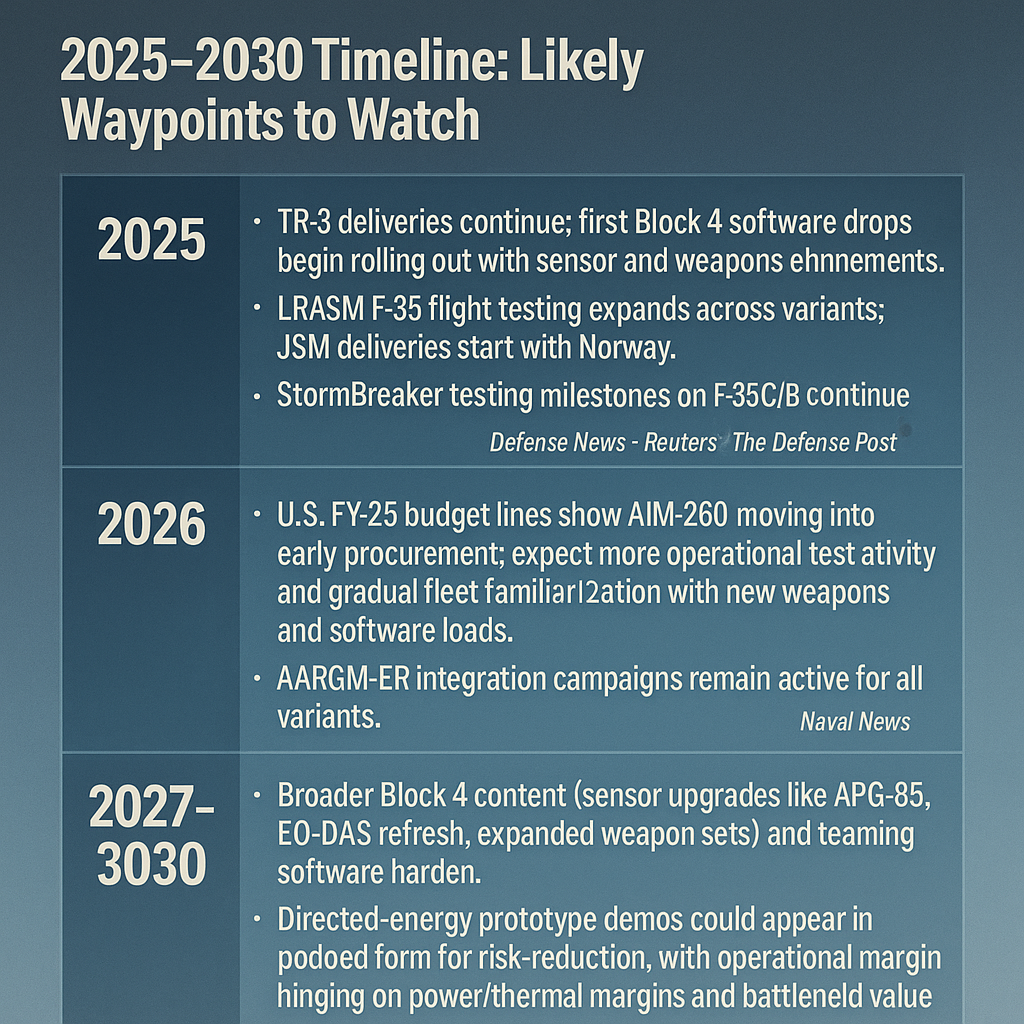
Buying, training, and sustainment implications
Mission data & software cadence: Block 4 means more frequent software baselines; squadrons will need robust Mission Data File pipelines and configuration discipline to keep fusion and weapon employment consistent across jets. Tactics and sims: AI-assisted cues and teaming shift crew resource management—sims should emphasize human-on-the-loop decision-making, sensor triage, and deconfliction with drones. Weapons planning: JATM/LRASM/JSM/AARGM-ER require refined weaponeering—from loadout planning to comms links and EMCON profiles. Maintenance: New sensors and pods add cooling and power management checks to standard turnaround flows; good news is that podded DE, if adopted, could reduce cost per intercept against UAS compared to missiles. Logistics: Expect inventory shifts (fewer AMRAAMs as JATM ramps, more JASSM/LRASM buys) and closer integration with joint/coalition stockpiles. Air & Space Forces Magazine
Risks and watch-items
TR-3/Block 4 schedule churn: Software complexity can slip; plan for staggered capability drops and mixed-configuration fleets during transition. Integration tail risk: Each new missile adds envelope, separation, and EMI/EMC variables that can push test schedules. DE practicality: Pod weight/drag and heat rejection could limit fighter-class lasers in the near term; expect more counter-UAS than full-up missile-kill roles at first. AI trust & governance: DARPA has shown AI can fly and fight, but policy, ROE, and certification will determine how far “autonomy” can go in frontline F-35 units. DARPA
Quick FAQ (for “People Also Ask”)
Will the F-35 carry a laser weapon by 2030? There’s no official fielding plan yet; the most likely path is podded demos that inform a later acquisition decision as power/thermal margins improve. Congress.gov
What new A2A missile replaces AMRAAM? The AIM-260 JATM begins U.S. procurement in FY-2026, with details on fleet integration progressing under classified and program-managed channels. Naval News
Which standoff missiles matter most for F-35 strike? LRASM/JASSM and JSM expand maritime and deep-strike options while preserving stealth carriage in some configs. ReutersMedia – Lockheed Martinkongsberg.com
How will AI show up in the cockpit? As prioritized tracks, recommended shots, and teaming orchestration—decision aids with the human in the loop. nationaldefensemagazine.org
When will Block 4 be “done”? It’s a rolling roadmap through the end of the decade, gated by TR-3 hardware, software maturity, and test capacity. The Strategist
Conclusion
The near-term F-35 story isn’t a single silver bullet; it’s a stack—more compute (TR-3), smarter software (Block 4), longer-reach missiles (JATM, LRASM/JASSM, JSM, StormBreaker, AARGM-ER), and AI-assisted cues that compress find-fix-finish timelines and coordinate manned-unmanned teams. Directed-energy remains the wild card: not fielded on the jet today, but increasingly plausible as a podded layer for point defense later in the decade if power/thermal solutions prove out. For operators, the right move is to train to the new decision flow (AI cues + teaming), modernize weaponeering and EW tactics for longer-reach fights, and keep software/configuration control tight as Block 4 features arrive in waves. The F-35’s edge has always been about fusion and networks; over 2025–2030, that edge widens—so long as fleets keep pace with the software and the weapons that make the airframe matter. Defense NewsNaval NewsReuters
For fresh context around F-35 upgrades, see the engine core roadmap in From F135 to 6th-Gen: CMCs & Cooling. For sustainment and parts flow that affect missile availability and pod turn-times, read MRO Market Trends 2025–2030: Engine Shop Capacity, TATs, and Labor Gaps. To understand how airframe drag budgets interact with internal/external stores, check How to Reduce Drag 12–20% with Ultra-Thin Wings.
